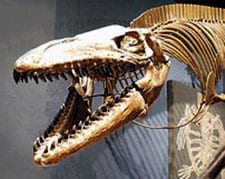Dallas — and much of Texas — was once submerged by a sprawling, blue-water ecosystem called the Western Interior Seaway, which split North America in two from the Gulf of Mexico to the Arctic Ocean, according to a new video documentary by the Discovery Channel.
“Prehistoric Dallas” includes commentary from two SMU paleontologists, Michael J. Polcyn and Louis L. Jacobs, both of whom have expertise in Texas’ ancient sea and the life that inhabited it from more than 90 million years ago until the extinction of the dinosaurs at 66 million years ago.
From Dallasaurus to Mosasaur
That animal life included the three-foot-long Dallasaurus, which represents an intermediate stage between land-dwelling lizards, similar to the modern day Komodo dragon, and fully marine-adapted Mosasaurs equipped with fin-like limbs and a fish-like tail.
Starting at about 100 million years ago, these small lizards took to the water, but quickly evolved into the huge marine creatures that grew to 50 feet in length by the end of the Cretaceous.
 |
| Michael Polcyn |
“(Dallasaurus) probably retained a swimming behavior very similar to what you see in modern lizards,” says Polcyn, whose appearance starts 38 seconds into the “Ocean Pioneer” segment.
The ancient sea covering Texas was clean, deep water, says SMU vertebrate paleontologist Jacobs at the start of the “Texas Submerged” segment. Evidence of that sea exists today in the 86-million-year-old fossils in the geological layer known as the Austin Chalk.
The layer is formed by plankton, Jacobs explains, which are minute organisms that live on the surface of the ocean, then die and filter down to the bottom.
 |
| Louis Jacobs |
“There was no mud and silt here, washed in from the land,” Jacobs says. “This represents the bottom of the sea, when the sea was at its deepest in this area.”
Polcyn and Jacobs are in the Roy M. Huffington Department of Earth Sciences, Dedman College.
Internationally recognized for his fossil discoveries, Jacobs joined SMU’s faculty in 1983. Currently he has projects in Mongolia, Angola and Antarctica. His book, “Lone Star Dinosaurs” (1999, Texas A&M University Press) was the basis of an exhibit at the Fort Worth Museum of Science and History that traveled the state.
Jacobs consulted on the new exhibit “Mysteries of the Texas Dinosaurs” at the Fort Worth Museum of Science and History. It includes the world’s first skeletal mount of the Texas state dinosaur Paluxysaurus jonesi. Jacobs narrates the video portion of the exhibit, which also includes SMU students Yuri Kimura, Dan Danehy and Kyle Paterson.
Polcyn, director of the Visualization Laboratory in the SMU Huffington Department of Earth Sciences, is an SMU adjunct research associate.
 |
| Mosasaur skeleton |
Polcyn is a world-recognized expert on the extinct marine reptiles called Mosasaurs.
Polcyn’s research also includes application of technology to problems in paleontology.
He recently created computer models to produce life-sized physical models of some of the Paluxysaurus jonesi bones for “Mysteries of the Texas Dinosaurs” at the Fort Worth Museum of Science and History.
Related links:
Louis L. Jacobs
Michael J. Polcyn
Agence France Presse: “Angola: Final frontier for fossils”
New Scientist: “Real sea monsters; The hunt for Predator X”
![]() Discovery Channel: “Mega Beasts: T-Rex of the Deep”
Discovery Channel: “Mega Beasts: T-Rex of the Deep”
SMU News: Dallasaurus, ancient mosasaur
Roy M. Huffington Department of Earth Sciences
Dedman College
 Dallas — and much of Texas — was once submerged by a sprawling, blue-water ecosystem called the Western Interior Seaway, which split North America in two from the Gulf of Mexico to the Arctic Ocean, according to a new video documentary by the Discovery Channel.
Dallas — and much of Texas — was once submerged by a sprawling, blue-water ecosystem called the Western Interior Seaway, which split North America in two from the Gulf of Mexico to the Arctic Ocean, according to a new video documentary by the Discovery Channel.